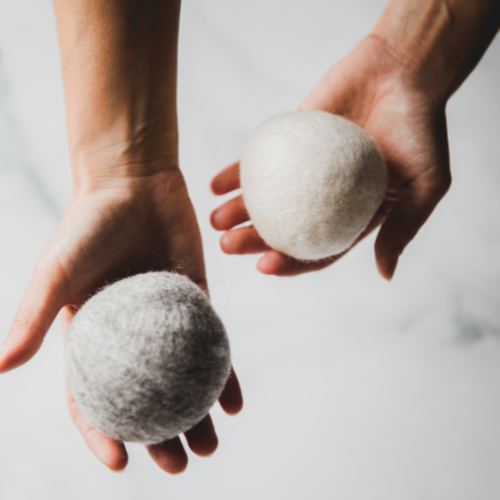
The arrival of cold weather often means the return of using the dryer for the majority of households in Quebec. Despite its ease of use, the dryer is not without its drawbacks. In fact, this household appliance consumes a lot of electricity and damages clothes which also often come out wrinkled. Also, depending on the composition of our clothes, the friction of fabrics can create static electricity.
To avoid some of these inconveniences, many families use fabric softener sheets. However, these sheets are single-use and are not compostable because they are made from polyester, a synthetic fiber derived from petroleum. Additionally, they contain fragrances and other compounds that are transferred to clothing during drying and may cause allergic reactions in some people. Finally, these sheets prevent different textiles such as towel terry from using their absorbent power by leaving a thin waterproof layer.
To make this routine gesture more eco-friendly, there is a simple solution: use wool drying balls !
Benefits of wool dryer balls
Natural
The wool used usually comes from sheep and sometimes alpaca. It is therefore a 100% natural fiber.
Reduced energy consumption
The principle of the dryer is to move the clothes in order to circulate hot air between them to dry them.
By adding dryer balls, the separation of fabric layers is done more efficiently, improving air circulation. This process therefore reduces the time required for drying and our energy consumption by up to 25% per load. A significant saving!
Finally, moving the balls in the dryer allows the clothes to separate better from each other, also saving time on ironing! Also, the separation of clothing allows animal hair to go more easily towards the filter of the device.
No added chemicals
Dryer balls are made from 100% wool. There is no addition of perfume or anti-static or softening products.
There are no dyes used in the manufacturing process, the color comes from the natural hue of the animal's wool.
Hypoallergenic
As they are made only of wool, the dryer balls do not leave residue on clothes, so there is no risk of developing a skin allergy.
Reusable
Each ball can be used for a minimum of 500 loads. At a rate of 5 loads per week, this represents a lifespan of at least 2 years.
On a personal note, our dryer balls are currently over 3 years old and they still work great!
Biodegradable
Made up of keratin, a natural protein, wool decomposes in just a few months .
Useful information
For optimal use, we recommend using 3 wool dryer balls for a small load and up to 6 balls for a large load.
It is important to note that the antistatic effect is more effective on natural fibers than synthetic ones, because the latter produce much more static electricity. It is therefore important here to reduce the drying time, since electricity is formed with the friction of dry clothes.
Interview
There is no need to wash dryer balls since they come into contact with clean clothes. If, however, an incident occurs, it is possible to wash the dryer balls in the washing machine with cold water. To do this, put them in a stocking or lingerie bag and wash them on a delicate cycle. It is possible to wash them by hand with mild soap. Some manufacturers indicate that this would restore their antistatic power, however we are not convinced of this assertion.
Ecological, but more expensive?
Many people mistakenly believe that replacing fabric softener sheets with wool dryer balls is more expensive.
In addition to a reduction in electricity costs associated with the use of the dryer of approximately 25%, the savings don't stop there!
Although dryer balls generally last longer than 2 years, let's assume a family doing 5 large loads per week and a lifespan of 2 years for the dryer balls:
|
|
Fabric softener sheets |
Dryer balls |
|
Number per load |
2* |
6 |
|
Cost per item |
$0.06** |
$8 |
|
Annual cost (260 loads) |
$31.20 |
$48 |
|
Cost over 2 years (520 loads) |
$62.40 |
$48 |
*Companies recommend using 2 sheets for a large load
**Average price in a big box store
After two years of use, this represents a saving of nearly $15 + electricity savings.
The initial acquisition cost is certainly higher, but it saves money in the long term!
Ecologically yours,






















2 comments
Bonjour, merci pour vos bon mots :) Les balles de séchage sont faites ici! La liste des ingrédients des produits cosmétiques et autres produits se retrouve dans la description de chacun des produits!. Au plaisir!
J’aimerais savoir où sont produites les balles, qui les fait et y a-t-il une liste d’ingrédients dans vos produits ? Merci bcp. Vos produits sont très intéressants et surtout écologiques.